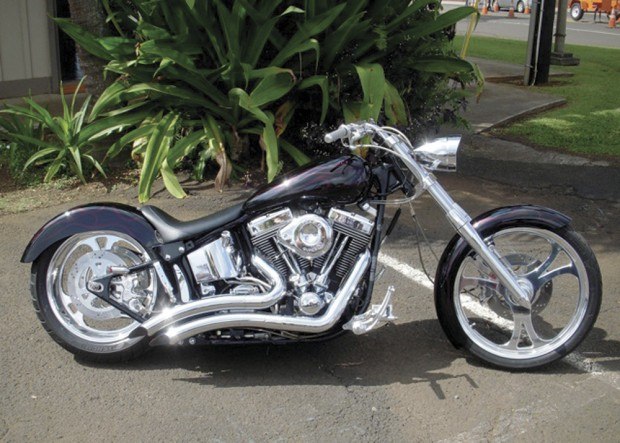William and Arthur tinkered with bikes in their hometown of Milwaukee, Wis., but when they put a motor on a bicycle, they had no idea they were starting something that would grow to be big — very big. Nor did
William and Arthur tinkered with bikes in their hometown of Milwaukee, Wis., but when they put a motor on a bicycle, they had no idea they were starting something that would grow to be big — very big.
Nor did they know their efforts would affect Mark Hamasaki’s life more than 100 later. William Harley and Arthur Davidson, along with Arthur’s brother William, teamed up and created a legendary American icon: Harley-Davidson Motors Company.
Wailua resident Mark Hamasaki has vivid memories of growing up on O‘ahu, where his uncles rode with the Sons of Hawai‘i. Motorcycle genes are in his blood; for him to get hooked on Harleys was to be expected. He used to ride dirt bikes with his employer, Rick at Burrell’s Painting. It was Burrell who influenced him to get his first Harley.
The boys from Milwaukee didn’t always have the right formula, but they weren’t afraid to experiment; an early prototype bike used an Evinrude outboard boat motor. Harley-Davidson got a big boost when they supplied 15,000 machines to the military during World War I. By 1920, they were the largest motorcycle manufacturer in the world, sold in 67 countries.
H-D was one of only two U.S. motorcycle makers to survive the Great Depression. The firm supplied an additional 90,000 machines for World War II, and fared well in the post-war boom. Then the Japanese attacked. No, this was not Pearl Harbor — it was Honda, which took its fun and affordable motorcycles to the U.S. in the 1960s. Harley-Davidson struggled and was sold to AMF in 1969. In 1981, it was sold again, but this time to a group of investors that happened to include William Davidson’s son, Willie.
Willie Davidson was a graduate of the Art Center College of Design and had worked in Ford’s design department. He is credited with resurrecting the Harley-Davidson brand by focusing on specialization and customization. The company abandoned small, lightweight motorcycles and concentrated on “Hogs.”
Harley-Davidson continues to expand its loyal customer base through clubs, events, museums and the licensing of the powerful Harley-Davidson brand and logo. Licensing alone brings in more than $40 million in revenue.
Hamasaki’s ‘91 Harley-Davidson is one fine example of the customization Willie Davidson had envisioned. This “pro street”-style bike was built on Kaua‘i by Spence at S&S Speed Shop, originally owned by a Wailua biker.
In 2007, Hamasaki bought the bike for $20,000 and then invested another $20,000 in additional modifications, also done by S&S. “Jay Boy” at Kaua‘i Harley-Davidson keeps the bike in tip-top condition.
For show, the tank and fenders were painted jet black with subtle fuchsia “ghost flames” rendered by Cosmic Airbrush Designs on O‘ahu. The front wheel was extended by tilting the front fork an additional seven degrees. Polished billet aluminum is a design theme carried out through the use of an aerodynamic Headwinds headlight. Performance Machinery controls with knurled handgrips on the 18s on the back.
In the “go” department, Hamasaki’s machine has an aftermarket Ultima El Bruto 107 cubic-inch engine that feeds into a stock Harley five-speed transmission. The standard chain drive was swapped out for an Ultima three-inch belt drive, resulting in a quieter, vibration-free ride.
For comfort, the rider sits astride a Danny Gray seat by Arlen Ness Designs. A Platinum adjustable air suspension smoothes out the bumps, and the whole package receives an exclamation point by way of the sparkling Vance & Hines downdraft exhaust pipes with viper-style hot tips. Just by looking, one can tell this isn’t your average Harley-Davidson!
Corrections and clarifications: Last week’s column stated that “Kaua‘i Classic Car Cruisers” gathers at Kukui‘ula Bubba Burgers (second Friday) and Hanapepe Art Night (third Friday). The group’s actual name is “Kaua‘i Kruisers,” not to be confused with “Kaua‘i Classic Cars,” a group often seen in local parades and at their own car shows.
• Wheels in Motion is a weekly feature showcasing interesting island vehicles and the unique people who own them. Email wheels@thegardenisland.com to suggest a vehicle that should be in the spotlight.


